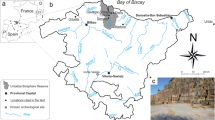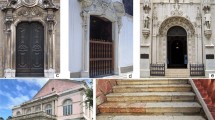Abstract
The ornamental use of marble from Macael region (Almería, southeast of Spain) began more than 5000 years ago. The first small objects are from the Neolithic period (3400–3000 B.C.) and the first known sculptures are from the Phoenicians period (fifth century B.C.) Since then, the marble’s use has been continuous, especially since the eleventh century. Some of the best known examples of Macael marble in Spain can be observed in Roman cities (e.g., Itálica), in Muslim buildings (e.g., Mosque of Córdoba or the Alhambra palace), or in Renaissance buildings such as the monastery of El Escorial, among many others. Some are declared World Heritage Sites by UNESCO. This makes the region one of the most important extraction centers in Spain, both at present and historically. The oldest and most famous variety of marble is known as White Macael (Blanco Macael). There are other marbles such as Gray Macael, Anasol Yellow Macael, and serpentinites which are traded as Green Macael. These have less importance in terms of their use in heritage but great importance in current regional trade. In this work, we provide a full characterization of the main characteristics of the White Macael marble from Macael and propose it as a candidate for “Global Heritage Stone Resource.” This work is important for duly recognizing a natural stone that has been used profusely in heritage buildings in the past and present with important international significance.








Similar content being viewed by others
References
Almagro-Gorbea M, López-Rosendo ME, Mederos-Martín A, Torres-Ortiz M (2010) Los sarcófagos antropoides de la necrópolis de Cádiz Mainake XXXII:357–394
Aznar-Sánchez JA, Carretero-Gómez A, Velasco-Muñoz JF (2015) An industrial district around a mining resource: the case of marble of Macael in Almería. J Reg Res 32:133–148
Bello MA, Martin L, Martin A (1992) Microchemical identification of Macael White marble in some Spanish monuments. Mater Constr 225:23–30
Beltrán-Fortes J, Loza-Azuaga L, Ontiveros-Ortega E, Rodríguez-Gutiérrez O, Taylor R (2011) La explotación y el empleo de marmora en la baetica. Un proyecto de investigación de base arqueométrica Itálica Revista de arqueología clásica de Andalucía 1:51–75
Benavente D, Martínez-Verdú F, Bernabeu A, Viqueira V, Fort R, García del Cura MA, Illueca C, Ordóñez S (2003) Influence of surface roughness on color changes in building stones. Color Res Appl 28:343–351
Cantó AM (1977) Avances sobre la explotación del mármol en la España romana. Arch Esp Arqueol 50-51:165–189
Carretero-Gómez A (1995) La industria del mármol en Almería. Servicio de Publicaciones de la Universidad de Almería, Almería
Carretero-Gómez A (2004) Dos décadas de expansión en el sector español del mármol. Rev Econ Ind 355/356:251–262
Carretero-Gómez A (2007) Desarrollo local: La comarca del mármol de Almería. In: Fernández-Navarrete D, de Pablo-Valenciano J (eds) Experiencias de desarrollo local. Aconcagua Libros, Sevilla, pp 131–149
Carretero-Gómez A, Aznar-Sánchez JA (2012) La política de desarrollo local en la comarca del mármol en Almería. Rev Estud Empresariales Segunda época 1:113–130
Carretero-Gómez A, Aznar-Sánchez JA (2017) Las canteras de mármol de Macael: de “libres y comunes a todos” a bienes municipales. Bol Geol Min 128:329–343. 10.21701/bolgeomin.128.2.004
Casares-López M (2009) La ciudad palatina de la Alhambra y las obras realizadas en el siglo XVI a la luz de sus libros de cuentas De Computis. Rev Esp Hist Contabilidad 10:3–130
Cervera L (1985) Años del primer matrimonio de Juan de Herrera. Albatros, Valencia
Cisneros-Cunchillos M (1988) Mármoles hispanos: su empleo en la España romana. Departamento de Ciencias de la Antigüedad. Universidad de Zaragoza, Zaragoza
Cisneros-Cunchillos M (1992) La explotación de los mármoles almerienses en la época romana. Roc Máquina 6:44–47
Cooper BJ, Marker BR, Thomas IA (2013) Towards international designation of a heritage dimension stone. Key Eng Mater 548:329–335. https://doi.org/10.4028/www.scientific.net/KEM.548.329
García-Entero V (ed) (2014) El marmor en Hispania: explotación, uso y difusión en época romana. Universidad Nacional de Educación a Distancia, Madrid
Grima J (1994) La explotación del mármol de Macael y de los Filabres a lo largo de la historia (I): Desde la antigüedad hasta el fin del periodo nazarita. In: Grima J, Martínez-Cosentino F (eds) La Piedra Natural. Su papel en la historia. Nuevo reto de la minería y la industria en España. Cursos de verano universidad complutense en Almería, Almería, pp 27–42
Gutiérrez-Pastor S (2004) El sector del mármol. Situación actual y perspectivas de futuro Boletín económico de ICE 2823:167–171
IGME (2017) GEODE: Mapa geológico digital continuo (on line). http://mapas.igme.es/gis/services/Cartografia_Geologica/IGME_Geode_50/MapServer/WMSServer. Accessed 06–04-2017
Lapuente P, Álvarez A (2014) Métodos para la identificación de los mármoles. In: García-Entero V (ed) El marmor en Hispania: explotación, uso y difusión en época romana. Universidad Nacional de Educación a Distancia (UNED), Madrid, pp 73–90
Lapuente MP, Turi B, Blanc P (2000) Marbles from Roman Hispania: stable isotope and cathodoluminescence characterization. Appl Geochem 15:1469–1493
Luque A (2010) Andalucian marbles: durability criteria applied in its use as ornamental stone. Dissertation, University of Granada
Luque A, Cultrone G, Mosch S, Siegesmund S, Sebastián-Pardo E, Lei B (2010) Anisotropic behaviour of White Macael marble used in the Alhambra of Granada (Spain). The role of thermohydric expansion in stone durability. Eng Geol 115:209–216
Luque A, Leiss B, Álvarez-Lloret P, Cultrone G, Siegesmund S, Sebastián-Pardo E, Cardell C (2011a) Potential thermal expansion of calcitic and dolomitic marbles from Andalusia (Spain). J Appl Crystallogr 44:1227–1237
Luque A, Ruiz-Agudo E, Cultrone G, Sebastián-Pardo E, Siegesmund S (2011b) Direct observation of microcrack development in marble caused by thermal weathering. Environ Earth Sci 62:1375–1386
Luque A, Martínez de Yuso MV, Cultrone G, Sebastián-Pardo E (2013) Analysis of the surface of different marbles by X-ray photoelectron spectroscopy (XPS) to evaluate decay by SO2 attack enviro. Earth Sci 68:833–845
Marker B (2015) Procedures and criteria for the definition of Global Heritage Stone Resources. In: Pereira D, Marker B, Kramar S, Cooper B, Schouenborg B (eds) Global Heritage Stone: Towards International Recognition of Building and Ornamental Stones, vol 407. Geol Soc London Spec Publ, pp 1–4. https://doi.org/10.1144/SP407.7
Martín-Algarra A, Alonso-Chaves FM, Andreo B, Azañón JM, Balanyá JC, Booth-Rea G, Crespo-Blanc A, Delgado F, Díaz de Federico A, Estévez A, Galindo-Zaldívar J, García-Casco A, García-Dueñas V, Garrido CJ, Gervilla F, González-Lodeiro F, Jabaloy A, López-Garrido AC, Martín-Algarra A, Martín-Martín M, Nieto JM, O'Dogherty L, Orozco M, Puga E, Rodríguez-Cañero R, Ruiz-Cruz MD, Sánchez-Gómez A, Sánchez-Navas A, Sanz de Galdeano C, Soto JI, Torres-Roldán RL, Vera JA (2004) Zonas Internas Béticas. In: Vera JA (ed) Geología de España. Sociedad Geológica de España (S.G.E.)-Instituto Geológico y Minero de España (I.G.M.E.), Madrid, pp 395–444
Martínez-Martínez JM, Soto JI, Balanyá JC (2002) Orthogonal folding of extensional detachments: structure and origin of the Sierra Nevada elongated dome (Betics, SE Spain). Tectonics 21:1012
MET (2017) Metropolitan Museum of Art New York http://www.metmuseum.org/art/collection/search/199003. Accessed 06–06-2017
Morbidelli P, Tucci P, Imperatori C, Polvorinos A, Preite Martinez M, Azzaro E, Hernandez MJ (2007) Roman quarries of the Iberian peninsula: “Anasol” and “Anasol”-type. Eur J Mineral 19:125–135. https://doi.org/10.1127/0935-1221/2007/0019-0125
Navarro R (2016) Estudio de las serpentinitas del Complejo Nevado-Filábride (Cordillera Bética). Usos y aplicaciones en construcción y patrimonio arquitectónico. Dissertation, University of Salamanca
Navarro R, Cruz A, Arriaga L, Baltuille JM (2013a) White Macael marble: a key element in the architectonic heritage of Andalusia for over 25 centuries. Geophys Res Abstr 15:EGU2013–EGU4252
Navarro R, Pereira MD, Gimeno A, Del Barrio S (2013b) Verde Macael: a serpentinite wrongly referred to as a marble. Geosciences 3:102–113
Navarro R, Pereira D, Rodríguez-Navarro C, Sebastian-Pardo E (2015) The Sierra Nevada serpentinites: the serpentinites most used in Spanish heritage buildings. In: Pereira D, Marker B, Kramar S, Cooper B, Schouenborg B (eds) Global Heritage Stone: Towards International Recognition of Building and Ornamental Stones, vol 407. Geol Soc London Spec Publ, pp 101–108. https://doi.org/10.1144/SP407.7
Navarro R, Pereira D, Arriaga L, Cruz AS (2016) The significance of Macael region (SE of Spain) in the use of the natural stone in Spain paper presented at the 35th International Geological Congress, Cape Town, 27 Aug – 4 Sep 2016
Navarro R, Cruz A, Arriaga L, Baltuille JM (2017a) Caracterización de los principales tipos de mármol extraídos en la comarca de Macael (Almería, sureste de España) y su importancia a lo largo de la historia. Bol Geol Min 128:345–393. 10.21701/bolgeomin.128.2.005
Navarro R, Pereira D, Carrillo G, Cruz AS (2017b) The Macael landscape in the context of a possible candidate as Global Heritage Stone Province (Almería, SE of Spain). Geophys Res Abstr 19:EGU2017–EGU8016
Origlia F, Gliozzo E, Meccheri M, Spangenberg JE, Turbanti Memmind I, Papi E (2011) Mineralogical, petrographic and geochemical characterisation of white and coloured Iberian marbles in the context of the provenancing of some artefacts from Thamusida (Kenitra, Morocco). Eur J Mineral 23:857–869
Padilla A (1999) Consideraciones en torno a la explotación del mármol en la Bética durante los s. I-II Habis:271–281
Pastor-Medina G (1990) Macael morisco y cristiano. Instituto de estudios almerienses, Ayuntamiento de Macael
Pereira D, Marker B (2016) The value of original natural stone in the context of architectural heritage. Geosciences 6:13. https://doi.org/10.3390/geosciences6010013
Pereira D, Page K (2017) A new IUGS Commission for Geoheritage: The ‘ICG’ Episodes 40:77–78
Pereira D, Marker B, Kramar S, Cooper BJ, Schouenborg B (2015) Introduction. In: Pereira D, Marker B, Kramar S, Cooper B, Schouenborg B (eds) Global Heritage Stone: Towards International Recognition of Building and Ornamental Stones, vol 407. Geol Soc London Spec Publ, pp 1–4. https://doi.org/10.1144/SP407.7
Quirós JA (1998) La sillería y las técnicas constructivas medievales: Historia social y técnica de la producción arquitectónica. Archeologia Medievale 25:235–246
Sáez-Pérez MP (2004) Estudio de elementos arquitectónicos y composición de materiales del Patio de los Leones. Interacciones en sus causas de deterioro. Servicio de publicaciones de la Universidad de Granada, Granada
Sáez-Pérez MP, Rodríguez-Gordillo J (2008) The influence of solar radiation on the deterioration of the marble columns in the courtyard of the lions in the Alhambra. Stud Conserv 53:145–157
Sáez-Pérez MP, Rodríguez-Gordillo J (2009) Structural and compositional anisotropy in Macael marble (Spain) by ultrasonic, XRD and optical microscopy methods. Constr Build Mater 23:2121–2126. https://doi.org/10.1016/j.conbuildmat.2008.10.013
Sancho JL (2004) El Palacio Real de Madrid. Patrimonio Nacional, Madrid
Sebastián-Pardo E, Rodríguez-Navarro A, Cultrone G, Urosevic M, Rodríguez-Navarro C (2006) Caracterización de la anisotropía textural de mármoles comerciales Macla 6:453–456
Siret E, Siret L (2006) Las primeras edades del metal en el sudeste de España. album. Edición Facsimilar. Dirección General de Cultura. Museo Arqueológico de Murcia, Murcia
Tárraga-Baldó ML (2009) Mármoles y rocas ornamentales en la decoración del Palacio Real de Madrid Archivo Español de Arte LXXXII:367–392
Acknowledgements
The authors want to thank the association “Macael Antigua” and the Association of Marble Businessmen of Andalucía (AEMA) for the supply some pictures and data to improve this work. IUGS and UNESCO are acknowledged for the continuous support of the research on natural stones and their implication in cultural heritage recognition through IGCP-637.
Our sincere thanks go to Nate Lawrence (Iowa State University) for his linguistic revision and suggestions to improve this paper.
The authors thank the two anonymous reviewers whose comments and suggestions helped to improve this manuscript.
Author information
Authors and Affiliations
Corresponding author
Rights and permissions
About this article
Cite this article
Navarro, R., Pereira, D., Cruz, A.S. et al. The Significance of “White Macael” Marble Since Ancient Times: Characteristics of a Candidate as Global Heritage Stone Resource. Geoheritage 11, 113–123 (2019). https://doi.org/10.1007/s12371-017-0264-x
Received:
Accepted:
Published:
Issue Date:
DOI: https://doi.org/10.1007/s12371-017-0264-x




